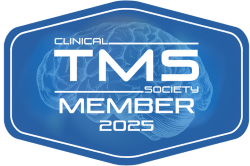
Transcranial Magnetic Stimulation (TMS) is an innovative treatment for mental health diagnoses such as depression, treatment-resistant depression, anxious depression, and obsessive-compulsive disorder (OCD).
TMS belongs to a category of treatments approved by the Food and Drug Administration (FDA) for mental health diagnoses called brain stimulation techniques (BSTs). Additional FDA-approved BSTs include electroconvulsive therapy (ECT) and vagus nerve stimulation (VNS). BSTs currently in the clinical trial phase include magnetic seizure therapy (MST) and deep brain stimulation (DBS). However, compared to the ECT, VNS, MST, and DBS, evidence shows TMS is less invasive, has fewer side effects, and can lead to long-term symptom relief.
TMS is an important tool for mental health providers who support people with obsessive-compulsive disorder (OCD). The World Health Organization (WHO) indicates that OCD was once among top ten most disabling illnesses worldwide, and the National Institute of Mental Health (NIMH) shows the following prevalence and other relevant data for OCD:
Obsessive Compulsive Disorder (OCD) Among Adults 18+
- Overall prevalence: 1.5-2.3%
- Severe impairment: 51%
- Moderate impairment: 35%
- Mild impairment: 15%
- Average ag of onset: 19
- Prevalence of comorbid psychiatric diagnoses with OCD: 90%
Traditional treatments for OCD include psychotherapy and medication. Common psychotherapeutic techniques for OCD include cognitive behavioral therapy (CBT), exposure response therapy (ERP), and eye-movement desensitization and response therapy (EMDR). Common medications for OCD include antidepressants such as Prozac, Lexapro, and others. New medications for OCD treatment include IV ketamine and oral ketamine.
However, evidence shows that roughly half of patients with OCD – 40 percent to 60 percent – do not experience symptom improvement with traditional therapeutic approaches. That’s why new treatments such as IV ketamine, oral ketamine, and the topic of this article – transcranial magnetic stimulation (TMS) – are welcome additions to the therapeutic techniques available to mental health treatment providers and their patients.
What is Obsessive-Compulsive Disorder (OCD)?
The Mayo Clinic defines obsessive-compulsive disorder as “…a pattern of unwanted thoughts and fears, called obsessions, that lead to repetitive behaviors, called compulsions. Obsessions and compulsions interfere with daily activities and cause significant psychological and emotional distress.” In addition, untreated OCD can lead to self-isolation, problems with work, school, and relationships, increase risk of alcohol and substance misuse, and increase risk of suicidal ideation and self-harm.
Obsessions associated with OCD include, but are not limited to preoccupation with:
- Cleanliness/contamination
- Violent thoughts regarding self and/or others
- Worry about causing harm self or others
- Perfectionism
Compulsions associated with OCD include:
- Repetitive washing/cleaning of hands, surfaces, etc.
- Repetitive checking for accidental mistakes, or checking about leaving on a light, the stove, or a faucet. Checking may also include constantly checking in on others to make sure they’re okay.
- Repeating common behaviors such as getting up or sitting down, opening and closing cabinets and doors, or repetition of self-grooming behaviors. People with OCD may also repeat movements like blinking, or repeat activities/behaviors a specific, predetermined number of times, or until the number “feels right.”
People with severe OCD report that on some days, obsessions and compulsions take up their entire day, and prevent them from participating in any typical activities at all. That’s another thing that makes TMS an important new development in the treatment of OCD. It can give people with severe, treatment-resistant OCD the chance to reclaim balance and control, reintegrate themselves into common activities, and live a full and fulfilling life that’s not dominated by managing their obsessions and compulsions.
How Does Transcranial Magnetic Stimulation (TMS) Work?
There are two different types of TMS that can help people diagnosed with OCD: repetitive TMS, called rTMS, and deep TMS, called dTMS. This article is about the latter – dTMS – which we’ll simply refer to as TMS.
Here’s how it works:
TMS: The Basics
- A cutting-edge, FDA-approved device, such as the BrainSway Deep TMS, generates magnetic pulses
- The TMS device delivers pulses to specific brain areas via a helmet placed on the patient’s head
- Treatment most often occurs in an outpatient office setting
- Treatment with TMS does not require anesthesia, sedation, or immobilization
- A TMS treatment session for OCD lasts around 20-30 minutes
Most patients engage in 20-30 sessions over several weeks. The schedule and exact number of sessions varies by personal need and individual treatment response. Patients report that treatment with TMS for obsessive-compulsive disorder is durable, and symptom relief often persists for months after the completion of a TMS treatment program for OCD.
In most cases, the subjective experience is easy and non-disruptive. Patients can engage in typical activities before and after TMS sessions for OCD. Here’s how the Mayo Clinic describes the subjective experience of engaging in TMS treatment for OCD:
TMS: The Subjective Experience
- You sit in a comfortable chair.
- The clinician gives you earplugs (TMS machines can be noisy) and prepares you for the session
- The clinician places the helmet on your head and initiates the treatment session
- You feel a tapping sensation on your head, where the coil is placed. The tapping lasts a few seconds, then stops, then the process repeats for the duration of the session.
- Sessions last roughly 20 minutes, depending on the technique used by the provider you choose
In some cases, patients report discomfort – in the form of tingling or mild pain – at the stimulation site, mild headache, and/or twitching of facial muscles. Patients report these side effects fade quickly after treatment, and may last roughly 1-2 hours.
The Evidence for TMS Treatment for OCD
The peer-reviewed journal publication “Transcranial Magnetic Stimulation in the Treatment of Obsessive–Compulsive Disorder: Current Perspectives” identifies four brain areas associated with OCD that clinicians target when using TMS for OCD:
-
Motor circuit/Sensorimotor circuit (SMA)
-
- Studies show altered function in this brain system, among people with OCD, may interfere with the suppression of intrusive, repetitive movements and thought.
-
Dorsal cognitive circuit/dorsolateral prefrontal circuit (dlPFC)
-
- This brain system is associated with executive cognitive functions, including adjustment of cognitive thought patterns. Research indicates that deficits in this brain circuit may increase attention to obsessive thoughts.
-
Ventral cognitive circuit (OFC)
-
- This brain system is part of the anterolateral orbitofrontal cortex (OFC). Studies indicate that excess activity in the OFC may be associated with obsessions, and that the OFC contributes to repetitive obsessive thoughts.
-
Affective anterior cingulate circuit (ACC)
-
- This brain system connects several brain areas associated with OCD, and participates in processing emotion and reward. In people with OCD, excess activity in this area is associated impaired behavioral response to various forms of external and internal stimuli.
When clinicians target these areas with TMS treatment in people with OCD, patients can experience significant symptom relief for both obsessions and compulsions. Evidence in the publication we introduce above, discussed in the bullet points above, shows the following.
Targeted TMS for Obsessive-Compulsive Disorder: Patient Outcomes
- Targeting the SMA results in significant, durable symptom reduction
- Targeting the OFC yields significant but temporary symptom reduction
- Evidence on targeting the dlPFC is mixed: some studies show robust response, others show no difference in outcome, compared to placebo/sham treatment
- Targeting the ACC is more effective with treatment with deep TMS (dTMS) as compared to repetitive TMS (rTMS).
That paper appeared in 2018. Since then, two large scale meta-analyses have confirmed and expanded upon these results:
- A study that analyzed data collected from over 2000 patients with OCD over twenty separate treatment locations showed that after one months, 73% of patients reported significant symptom reduction.
- Another study that collected data from close to 100 patients at 11 treatment locations showed that 45% of patients with treatment-resistant OCD report significant symptom reduction after one month of treatment.
These findings – and the use of TMS for patients with OCD and treatment resistant OCD – represent a significant step forward in OCD treatment. Patients with OCD who’ve tried all the standard approaches without success – including psychotherapy, medication, and lifestyle changes – may find success with TMS.
Is TMS Right For You?
Transcranial magnetic stimulation (TMS) may be appropriate for you if:
- You have obsessive-compulsive disorder (OCD) and are seeking treatment
- You think you have OCD and think you may need treatment
- You’ve received a diagnosis for OCD and have tried traditional treatment without success
If you, a friend, or a loved one meet any of those three criteria, we encourage you to find a treatment professional who offers TMS, or a treatment center that offers TMS, and arrange for a consultation with a licensed and experienced mental health provider.
TMS for Obsessive-Compulsive Disorder (OCD) at Relief Mental Health
At Relief Mental Health, we’re ready to meet you, learn about your individual history and personal treatment needs, and design a treatment plan that gives you the best chance of success. We have extensive experience using TMS to help patients manage the symptoms of OCD. We know we can help patients with OCD, whether its mild, moderate, or severe. We’re one of the first treatment centers in the country to use the BrainsWay Deep TMS system – and we’re committed to using this technology to help people find relief.
Call us today to schedule a consultation: our staff will help you determine which location and therapist is the right fit for your needs.


